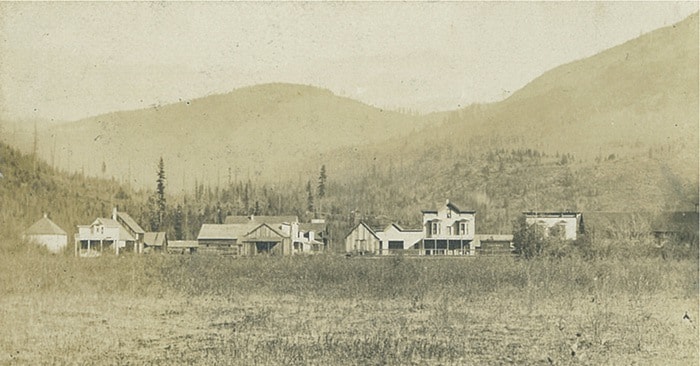An incredibly rare postcard of Erie, a ghost town west of Salmo, sold on eBay this month for $115 US. It shows the community from a distance, ca. 1905, with the bay-windowed Mersey Hotel most prominent among the false-fronted buildings lining First Avenue.
The town came to life as a result of promising finds on the north fork of the Salmo River in 1896. Originally called North Fork or Gilliam’s, Erie might have been named after the city in Pennsylvania — or for the Erie Mining and Milling Co. and Erie Consolidated Mining Co., both founded in 1897. They in turn might have taken their names from Erie Mountain, although the former also owned a claim in the Slocan called the Erie.
Mark Gilliam built a hotel near the Nelson and Fort Sheppard Railway depot on the northeast side of what’s now known as Erie Lake, and a townsite was laid out with numbered avenues parallel to the tracks. The cross streets were named after gemstones: Agate, Coral, Topaz, Crystal, Garnet, Ruby, Opal, and Pearl. (Only the latter three survive today.)
The chief mines in the area were the Second Relief and Arlington, but there were many others.
Clara Graham, who taught at Erie in 1913, recalled in Kootenay Yesterdays that in addition to its hotels, “The village consisted of two general stores, one of which contained the post office and drug store ... run by James R. Hunnex, a temperamental Englishman who previously operated stores at Waterloo and Trail.”
W.T. Beadles kept the other store while John P. Bell ran a livery stable. Bell later moved his large family into Beadles’ store, and hosted lively parties. “When John Bell played his fiddle and someone else performed on the piano this was indeed the highlight for all,” Graham wrote. The parties ended one winter night when the house burned down, after which the Bells moved to Park Siding.
In a cabin near the railway trestle over Erie Creek lived newlyweds Joe and Hattie Read, who became leading citizens. Joe opened a store, ran the post office, and was school board secretary. Hattie was known for her homemade bread and was a prospector who “occasionally washed sizable quantities of gold dust from the nearby stream.”
Erie’s heyday ended by the 1940s as the mines played out. Today it has a few homes and some surrounding businesses, including the White Line truck stop, where portions of The Tall Man were filmed in 2010. Highway 3 cuts through the north end of the original townsite.
Few photos of the town exist, much less on postcards. The one in question, while unused, had “Frances Rowe” on the back. The same seller auctioned four other cards Frances’ brother Andrew had sent her and their parents from Montreal and St. John, NB in 1909, one of which had an Erie postmark. They sold for $10.50 US. A 1938 Erie postmark also went this month for $15.50 Cdn.
Next week: a profile of James R. Hunnex.
